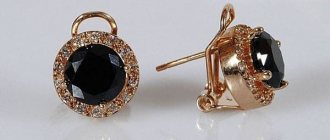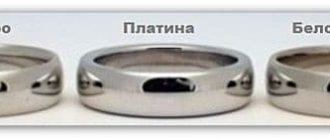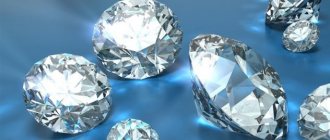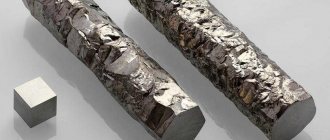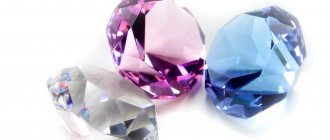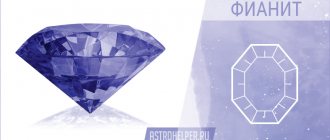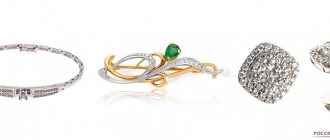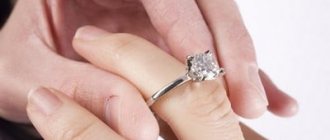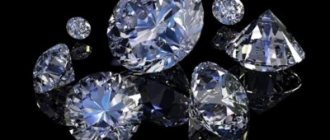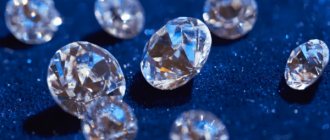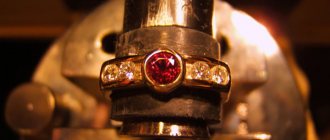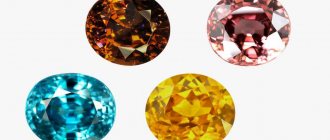Diamond is one of the most beautiful gems. Not only is it famous for its beauty, it is also very expensive. In order for jewelry to sparkle with such beauty, scientists have created a mineral that is also beautiful, but does not have the characteristics of a diamond. And it costs much less. This is cubic zirconia.
Not everyone can distinguish the difference at all . It’s okay if the buyer deliberately chose cubic zirconia, but if unscrupulous sellers passed off the artificial gem as a diamond, it already “smells” of fraud. To avoid this, you need to know how to distinguish a diamond from cubic zirconia.
What is a diamond
A diamond is a precious stone that is obtained as a result of cutting a diamond. Some people believe that a diamond and a diamond are completely different natural formations, but this is not so. Diamond serves as the raw material for producing a polished diamond. But not every diamond can be called a diamond. Brillant - “brilliant, sparkling”, only a diamond is called to which a special diamond cut has been applied, which reveals its natural brilliance to the maximum.
In cutting, precision and proportionality of the edges are valued. The highest quality cut is indicated by the letter “A”. Next come the letters “B”, “C”, “G”. The world system uses designations such as “Excellent” - an ideal cut.
Attention! Previously, a diamond was called a diamond.
How to determine in a ring?
You can check a fake by eye in a ring or in earrings by looking at the markings. Natural stone is always framed with precious metals, which are marked with special stamps.
It is recommended to look for the 14K, 750, 900 signs on gold products, and PT and Plat on platinum products. Another way is to look closely at the stone.
To achieve shine and play of light, the diamond is placed in an open frame; this method of mounting allows you to see the lower edges of the diamond.
A sign of a fake is the mirror coating of the lower edges.
What is cubic zirconia
Cubic zirconia is an artificial mineral that was created by the Physical Institute of the USSR Academy of Sciences (FIAN) in 1970. In honor of this institute, it was named cubic zirconia. People abroad call this mineral zirconite, also known as zirconium and zircon. But this is a misnomer, since zirconite, zirconium and zircon are three completely different materials.
The refractive index of cubic zirconia is very close to that of diamond. This quality of artificial mineral was first used for the manufacture of laser devices. And only much later this artificial stone began to be widely used in imitation diamond products.
Important! Scientists have learned to make cubic zirconia colored, which added value to this stone in jewelry.
Description of the stones
Gems differ in origin. This leads to their physical characteristics and cost. A-priory:
- A diamond is an organic rock of volcanic origin. Diamonds (rough diamonds) are mined from the depths of the earth near geysers or volcanoes. Later they are cut in a special way.
- Cubic zirconias are synthesized zirconium dioxide crystals obtained by high-frequency melting. Cubic zirconias are processed to look like diamonds, but with fewer facets.
The refractive indices of stones are similar in value. This makes them shine, shimmer from the inside, playing with light.
Cubic zirconias also differ from diamonds in their hardness. Diamonds are considered the hardest gems in the world.
View this post on Instagram
Posted by Engagement Rings DIAMONDS (@wow.shine_jewelry) Jul 19, 2022 at 5:40 am PDT
Key differences between diamonds and cubic zirconias
It would seem that artificial and natural minerals may be almost the same , however, they have significant differences:
- a diamond is 2-3 times lighter than cubic zirconia;
- the edge of a diamond is smoother, clearer, sharper, while cubic zirconia has softer, rounded edges;
- The wettability of fat in a diamond is good, the shape of the mark is retained, but in cubic zirconia such a mark spreads into a shapeless blot;
- Diamond has a high thermal conductivity, so it does not fog up. Cubic zirconia cannot “boast” of this; its conductivity is much lower, so fogging can occur on its surface;
- Natural stone has great radiance. Cubic zirconia has an interesting feature - if the crystal is large, then the power of radiance is low, but if the crystal is small, then its power is higher.
These differences clearly show where nature has worked and where the product of human activity. It is impossible to fake or get rid of these differences. But there is one “But” - such differences cannot be seen by eye .
A moment of history
Diamond mining is a very difficult and very profitable business. Everyone knows about the gold rush, but few know that there was also a diamond rush. At the end of the 19th century, rich diamond deposits were discovered in Africa. The news quickly spread across the Old and New Worlds, and prospectors of all stripes flocked to South Africa. Subsequently, the city of Kimberley was founded there.
Miners of the past believed that diamonds formed in river beds. The truth turned out to be different: in fact, 90% of diamonds are mined in kimberlite pipes - natural wells of volcanic origin. These formations were named after that African settlement. They look like this:
Diamonds are found on all continents except Antarctica. In addition to Africa, large deposits of the valuable mineral are located in Russia, Australia and Canada.
The value of diamonds is partly due to the complexity of their processing. It is believed that diamond is an incredibly hard material that can cut glass and metal. This is true. However, the other side of the coin is increased fragility. The mineral is almost impossible to scratch, but relatively easy to break. Because of this, they did not dare to process it for a very long time, and only in the 15th century did the Indians offer an effective technology for making diamonds.
The word “diamond” itself translated from French means “shining, bright, brilliant.” This perfectly reflects the main thing in the appearance of the stone and the very thing for which beauty connoisseurs love it.
Basic characteristics of a diamond
The value of each gemstone must be determined by its characteristics. A diamond has this:
- Carat
- Cutting Features
- Color
- Purity of the stone
Carat
A carat is a special measure of the weight of precious stones or pearls.
Previously, in order to determine the weight of gems, carato grains were used (ceratonia grains, this plant grew where the gems were mined). Acacia grains were also used, but the name came precisely from ceratonia grains.
These grains always had the same weight - 0.19. But in 1907, the carat weight was approved - 1 carat is equal to 200 milligrams. The carat is designated as "ct". Of course, the more weight a gemstone has, the more valuable it is.
Feature of the cut
How many faces a stone has, what shape it is – all this is determined by the cut. Sometimes more than half of its mass is lost during the processing of a diamond.
Today there are many programs that allow you to lose a lot of natural material to a minimum, but you cannot do without losses.
You can process a natural crystal into “oval”, “radiant”, “drop”, “heart”, emerald” and others. The mineral may be round or cubic .
With the most complex cut, the stone has up to 102 facets.
Attention! Artificially created minerals have more symmetrical edges, but natural stones may have some errors.
Color
Diamond, while still in nature, experienced all sorts of environmental influences. This could not but affect the color of the stone. Therefore, diamonds can be of the following colors: brown, sand, yellowish, brown, smoky, colorless, green, blue, pink, red.
Red gems are the most prized because they are the least common. Gray and black diamonds are also found, but they are not used in jewelry. When making artificial stones, you can achieve a clearer and brighter palette of colors.
Important! There are legends that black diamonds are the most valuable. This is wrong. High-quality black diamonds are not found in nature, so such stones are not used for jewelry. Sometimes they are used as auxiliary in the manufacture of large jewelry - crowns, tiaras.
Purity of the stone
During the natural formation of a diamond, dots, some inclusions, and foreign crystals may enter its composition. This may not even be noticed by the ordinary eye, however, with the help of a magnifying glass they will immediately become visible. But this is not the main thing. An unclean stone will fail to reflect. This means its value will fall.
This is so important that jewelers even came up with a certain classification of such defects:
- dots;
- voids;
- feathers;
- clusters of points.
International jewelers are more precise in their determinations of stone purity. They have developed the following system:
- Flawless is a perfectly pure mineral;
- Internally Flawless - close to ideal;
- Very Very Small Inclusions - there are very minor inclusions;
- Very Small Inclusions - the presence of very small inclusions is noted;
- Small Inclusions - inclusions of small size;
- Imperfect - copies are far from ideal.
Important! The purity of the stone must always be indicated on the tag.
Entertaining secrets
Most people are convinced that a diamond cannot be seen in water, but this is just a myth and a general misconception. Stones of natural origin almost always have a yellowish tint, so they can be seen in water with the naked eye. Even specimens devoid of color are clearly visible.
Diamonds cannot be present in jewelry; if the seller claims that the jewelry contains a natural stone, then this is not true.
It is advisable to never visit dubious places to purchase diamonds; you can also always request a certificate for jewelry and read the documentation.
Comparison of a real diamond and a fake at home
There are ways to help reveal the authenticity of stones at home .
To do this, you need to make small comparisons and this can be done in several ways:
- availability of a certificate - if the jewelry is purchased in a specialized store, then a certificate is issued for all jewelry. All the characteristics of the crystal are described there, including its authenticity;
- A very interesting test - you can drop some vegetable oil on the decoration. Fat will immediately drain from natural stone, but on the surface of cubic zirconia, a drop will spread into uneven smudges. In addition, the greased surface of the diamond will stick to the glass, but cubic zirconia will not stick;
- A real mineral cannot be warmed if it is heated in a fist, but cubic zirconia will become warm. And when you breathe on cubic zirconia, it will fog up, but the real mineral will remain transparent;
- price - an expensive stone cannot have a cheap price. In addition, such a product does not deteriorate, which means there cannot be serious discounts and promotions on natural stones;
- purity - a perfectly pure gemstone can only be man-made. If there is a flaw, you can calm down - nature has worked on it;
- You can ask the seller for permission to scratch the stone on your ring. Nothing will be done to the diamond, but the fake will not withstand such “bullying”, and the seller will get nervous, or even not allow the gem to be subjected to such execution;
- It has already been said above that the edges of a diamond are sharp and symmetrical, but those of cubic zirconia are slightly rounded. True, this will require a large magnifying glass;
- run a nail file over your pebble (if you don’t mind). The diamond will remain visible in its original state, but the cubic zirconia will be scratched;
- you can check the stone with water - the real mineral will immediately sink to the bottom, but the cubic zirconia will float on the surface;
- If you decide to buy a large stone, look through it into the light. Fianti is so transparent that you can see the landscapes. And the natural stone will be cloudy;
- if the ring and earrings are with natural stone, then they have a frame made of gold or platinum of the highest standard. If the jewelry is made of cubic zirconia, then there may be gold, but of low standard. And it happens that ordinary steel alloy is used;
- under ultraviolet rays, jewelry made of natural stone will begin to emit a dim blue light, and cubic zirconia will begin to phosphorize;
- Suitable only in cases where the stone is not inserted into the decoration. You will need to weigh the stone, then reset the scales, place a glass of water on the electronic scale, fasten the stone to a thread and lower it into the glass of water without touching the walls. Divide the previous weight of the stone by the indicator that appears on the scales now, and if the density of the stone is 3.51, then you can be congratulated - the stone is real. If the result is 6, 2 or higher, you have cubic zirconia in your hands;
- if you heat a stone over a fire (lighter or burner) and then sharply throw it into cold water, the cubic zirconia will crack due to the temperature difference, but nothing will happen to the diamond;
- They say that you can check the authenticity of stones using a magnet. However, the diamond could not be tested in this way;
- cubic zirconia, even with a small stream of light that falls on it, shimmers greatly. This is easy to explain - a diamond produces one ray. If light falls on it, and cubic zirconia always “copies” its rays, they double.
Don't overpay for something cheap
As you can see, recognizing a fake is not too difficult, but a specialist will still do it with one hundred percent accuracy. You should not be lazy in such a serious matter as buying jewelry - this can lead to extremely unpleasant consequences.
And remember: offers in the style of “jewelry for only 3000 (4000, 6000, 8000, etc.) rubles” are always false. Under the guise of a sale, scammers simply hand out glass pieces for large sums.
Buying jewelry is a difficult task that requires certain knowledge. You should know based on what parameters you can see a fake. Fortunately, the above methods will allow even an unknowing person to select a real diamond.
Remember that all this applies not only to transparent diamonds - zirconite is sometimes substituted for colored stones, simply giving them the desired color with the help of chemical additives. Sometimes they also replace other jewelry. Unscrupulous traders often try to make cheap jewelry more expensive in order to make a profit. A well-informed person will not fall for such tricks, so know how to distinguish a precious stone from an artificial one.
Read also: how to identify a diamond at home →
Professional authentication methods
There are also professional methods to check the naturalness of stones:
- The reflectivity of diamond and other stones are different. Therefore, they take a special device and measure the reflection;
- synthetic stones are semiconductors, which means they conduct electricity. All that remains is to force them to demonstrate this quality in laboratory conditions;
- a powerful microscope will show what is impossible to see even through the most powerful magnifying glass. By the way, it has already been written that the edges of diamonds are sharp and clear, while those of cubic zirconia are slightly rounded. This will be enough for a specialist. Also, inclusions and color of the stone will be taken into account;
- cubic zirconia, rock crystal and glass - give an X-ray image, while a real diamond is transparent to X-rays;
- special carat scales will also help professionals, because the ratio of mass and weight of diamond and cubic zirconia is different. Cubic zirconia is heavier.
Attention! Professional distinction methods should only be carried out in laboratories or special facilities.
Documents for purchasing a diamond
When purchasing diamonds, the buyer has the right to request a special product passport, a GIA certificate. This document states:
- crystal weight;
- cleanliness parameters;
- defects;
- origin of the stone.
Note! The seller is obliged to provide a passport/certificate for the gem free of charge. You can request paperwork for your diamond at any point of purchase (such as a large Sunlight chain or a small retail store). Any excuses and refusal to show documents about the manufacturing plant may indicate a forgery.
What to choose - a product with cubic zirconia or diamond
It is not necessary to buy jewelry with a diamond. Cubic zirconia has its advantages - it is cheaper and sparkles brighter. It has very high aesthetic qualities. However, one “But” should be remembered here - diamond products are always made from gold and platinum of the highest standard.
That is, if you bought earrings with cubic zirconia, be prepared for the fact that the gold in them will be of low quality. Still, what to choose is up to the buyer.
Important! You can listen to this, or you can ignore it, but it is believed that a woman cannot buy diamonds for herself; they bring good luck only when given to her beloved man.
How to distinguish using a tester?
Diamond Tester
The Diamond Tester, a special device for authentication, is in great demand today.
The technique is used to measure the thermal conductivity of a material, which allows an effective result to be obtained.
The tester is recommended for those who frequently buy diamonds.
It is worth noting that even this does not always give an accurate result, since scammers have begun to make cubic zirconia with a precious coating.
Crystalline substrates are coated with a film of crystallized carbon, which makes it possible to fool most portable tester models.
Astrological compatibility
Each zodiac sign will feel the support of its amulet:
Gemini will get rid of talkativeness and gain prudence, wisdom and orderliness.
Aries by slightly cooling the temperament; this sign is most impressed by the precious stone.
Leo will find harmony with himself, the talisman will support him in his career, as well as in love affairs.
Virgo will be able to dispel disagreements in the work team.
Cancers will become more attractive in the eyes of the opposite sex.
Libras will liberate themselves, freeing up their creative abilities.
Sagittarians will achieve great success in their studies, as well as in creativity or any other activity.
Scorpio dumps accumulated negative emotions onto cubic zirconia, strengthening family ties.
For Capricorns, jewelry with cubic zirconia will bring financial prosperity and good luck in the family.
Pisces will reveal their intuitive abilities, become more practical, and this will help attract finance.
Aquarius will become relaxed in communication, which will help win the favor of colleagues.
Even an artificial stone with a small piece of nature can become not only a beautiful decoration, but also a favorite talisman.
Cubic zirconia value by color
- Blue is a symbol of creative people, conducive to the development of talents.
- Blacks are suitable for business people; they are responsible for wit, controllability, and prudence.
- The green color will help an embittered person; this stone calms the temper; in addition, the amulet will be useful for those who want to feel unity with nature.
- A colorless stone is a symbol of sincerity and openness, a mineral in a silver frame, a suitable talisman for brides.
- The yellow variety is suitable for unhappy people, absorbs sadness, and helps cope with life's disappointments.
- The blue mineral helps the user achieve their goals.
